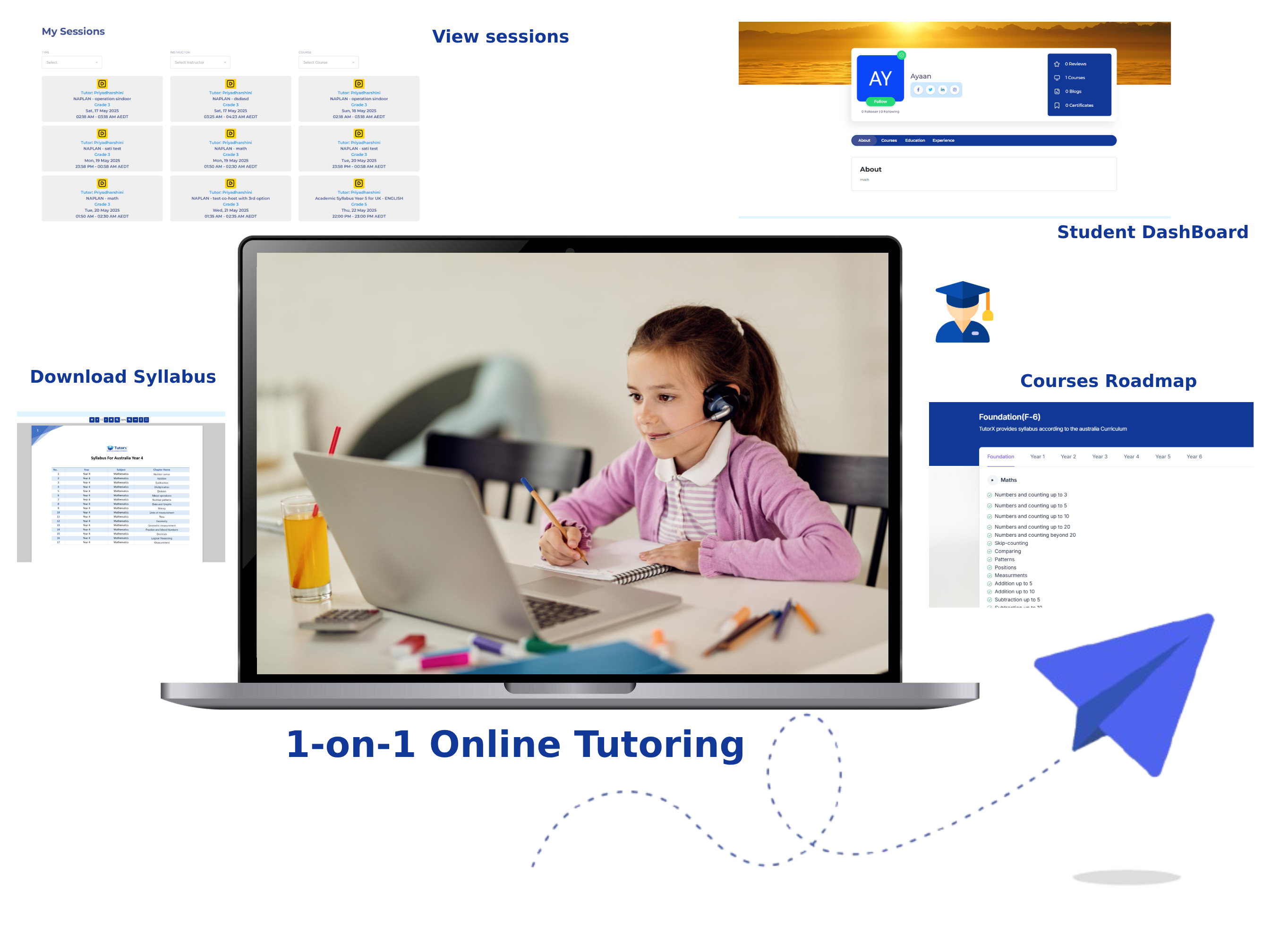Book a free trial session and start your personalized learning journey with our expert tutors.
Fill out the form below and one of our experts will contact you shortly.
Everything You Need, All in One Place
At The TutorX, we believe learning should be clear, focused, and at your fingertips. That’s why we’ve built a smart and user-friendly dashboard to empower every student on their academic journey. From live sessions and homework to performance tracking and resources—everything is seamlessly integrated to help you stay ahead with confidence.

The ISEB (Independent Schools Examination Board) Common Pre-Test is a standardized online assessment used by many independent senior schools as part of their admissions process for entry at 11+ or 13+. What sets the ISEB apart from traditional entrance exams is that it is adaptive—the difficulty of questions adjusts in real time based on the student's performance. As a student answers correctly, the next question becomes more challenging; if they answer incorrectly, the questions become slightly easier. This approach provides a more accurate picture of each student’s individual ability. Unlike conventional paper-based exams, the ISEB Common Pre-Test is a digital, multiple-choice test that evaluates key academic skills in the following areas: Verbal Reasoning, Non-Verbal Reasoning , English and Mathematics Because of its adaptive format and unique structure, succeeding in the ISEB Common Pre-Test requires specific preparation techniques and a strategic approach tailored to this style of assessment.

The ISEB Pre-Tests are a set of four online, age-standardised assessments used by many UK independent schools for admissions. They are typically taken by students in Year 6 or Year 7 and measure both academic attainment and potential. The results are shared with all schools a child applies to, so only one test is needed per academic year.
| Section | Time | Skills Tested |
|---|---|---|
| English | 40 minutes |
Reading comprehension, grammar, spelling, punctuation, cloze sentences, shuffled sentences |
| Mathematics | 40 minutes |
Problem-solving, calculation, measurement, geometry, statistics, age-appropriate math |
| Verbal Reasoning | 25 minutes |
Problem-solving with words and letters, synonyms, antonyms, word combinations, codes |
| Non-Verbal Reasoning | 30 minutes |
Visual and spatial reasoning, shapes, patterns, diagrams, 2D & 3D analysis |
The ISEB (Independent Schools Examination Board) Pre-Tests are a series of four online, adaptive assessments used by many leading independent schools in the UK. Typically taken by students in Year 6 or Year 7, these tests provide a holistic view of a child’s academic ability and potential across core subjects. Each section is uniquely designed to assess different cognitive and curriculum-based skills.
This section is designed to measure a child’s mathematical reasoning and problem-solving skills. It includes topics such as number operations, fractions, decimals, percentages, measurement, geometry, and statistics. Questions often place familiar concepts in unfamiliar contexts, encouraging students to apply their knowledge creatively and logically to solve new types of problems.
The English section evaluates a student’s grasp of language, focusing on reading comprehension, grammar, and vocabulary. Pupils are presented with both fiction and non-fiction texts, followed by questions that test their ability to interpret and analyse content. The assessment covers core areas such as spelling, punctuation, grammar, inference, and sentence structure, allowing schools to gauge both technical proficiency and comprehension depth.
Verbal Reasoning tests a student’s ability to think logically using language and word-based patterns. Tasks involve identifying synonyms and antonyms, decoding word-based patterns or analogies, and understanding sequences. These questions are crafted to measure how well a student can manipulate, interpret, and connect language-based information—key indicators of verbal aptitude and reasoning strength.
This section focuses on assessing visual and spatial intelligence through puzzles involving shapes, patterns, and diagrams. Students must recognise relationships, complete sequences, and solve problems based on visual information. It is designed to test abstract thinking and the ability to work with complex visual stimuli—skills not directly tied to school curricula but crucial for overall cognitive development.
The ISEB Common Pre-Test does not have a fixed pass mark, as each independent school sets its own admissions criteria. Instead of a traditional score or percentage, students receive a Standardised Age Score (SAS).This score is calculated using:
The number of correct and incorrect answers.
The difficulty level of the questions answered (as the test is adaptive).
The student’s age in months, to ensure fairness across the academic year.
100 is the average score.
120+ is considered strong and may be required for entry into more competitive schools
142 is the maximum possible score and below 82 is considered a low score.
| Subject | Time | Description |
|---|---|---|
| Mathematics | 40 minutes | Based on Key Stage 2 curriculum (up to end of Year 5). Tests numerical reasoning, problem-solving, calculation, measurement, and geometry. |
| English | 40 minutes | Covers reading comprehension, grammar, punctuation, and spelling using fiction and non-fiction texts. |
| Verbal Reasoning | 25 minutes | Assesses logical thinking using words. Includes synonyms, antonyms, word codes, analogies, and sequences. |
| Non-Verbal Reasoning | 30 minutes | Focuses on visual and spatial reasoning with shapes, patterns, and diagram-based questions. |
Administrator

Lorem Ipsum is simply dummy text of the printing and typesetting industry. Lorem Ipsum has been the industry's standard dummy text ever since the 1500s, when an unknown printer took a galley of type and scrambled it to make a type specimen book.
Lorem Ipsum is simply dummy text of the printing and typesetting industry. Lorem Ipsum has been the industry's standard dummy text ever since the 1500s, when an unknown printer took a galley of type and scrambled it to make a type specimen book. It has survived not only five centuries, but also the leap into electronic typesetting, remaining essentially unchanged. It was popularised in the 1960s with the release of Letraset sheets containing Lorem Ipsum passages, and more recently with desktop publishing software like Aldus PageMaker including versions of Lorem Ipsum.
Reach out to TutorX your questions spark the path to smarter learning
